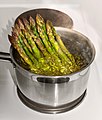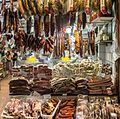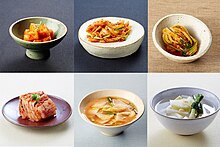Portal:Food
F o o d
A portal dedicated to food and foodways
Introduction
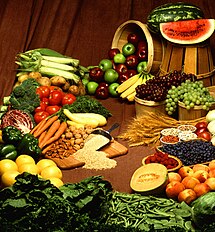
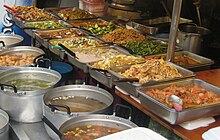
Food is any substance consumed by an organism for nutritional support. Food is usually of plant, animal, or fungal origin and contains essential nutrients such as carbohydrates, fats, proteins, vitamins, or minerals. The substance is ingested by an organism and assimilated by the organism's cells to provide energy, maintain life, or stimulate growth. Different species of animals have different feeding behaviours that satisfy the needs of their metabolisms and have evolved to fill a specific ecological niche within specific geographical contexts.
Omnivorous humans are highly adaptable and have adapted to obtain food in many different ecosystems. Humans generally use cooking to prepare food for consumption. The majority of the food energy required is supplied by the industrial food industry, which produces food through intensive agriculture and distributes it through complex food processing and food distribution systems. This system of conventional agriculture relies heavily on fossil fuels, which means that the food and agricultural systems are one of the major contributors to climate change, accounting for as much as 37% of total greenhouse gas emissions. (Full article...)
Cooking, also known as cookery or professionally as the culinary arts, is the art, science and craft of using heat to make food more palatable, digestible, nutritious, or safe. Cooking techniques and ingredients vary widely, from grilling food over an open fire, to using electric stoves, to baking in various types of ovens, reflecting local conditions. Cooking is an aspect of all human societies and a cultural universal.
Preparing food with heat or fire is an activity unique to humans. Archeological evidence of cooking fires from at least 300,000 years ago exists, but some estimate that humans started cooking up to 2 million years ago.
The expansion of agriculture, commerce, trade, and transportation between civilizations in different regions offered cooks many new ingredients. New inventions and technologies, such as the invention of pottery for holding and boiling of water, expanded cooking techniques. Some modern cooks apply advanced scientific techniques to food preparation to further enhance the flavor of the dish served. (Full article...)
Clotted cream (Cornish: dehen molys, sometimes called scalded, clouted, Devonshire or Cornish cream) is a thick cream made by heating full-cream cow's milk using steam or a water bath and then leaving it in shallow pans to cool slowly. During this time, the cream content rises to the surface and forms "clots" or "clouts", hence the name. Clotted cream is an essential ingredient for cream tea.
Although its origin is uncertain, the cream is associated with dairy farms in South West England and in particular the counties of Devon and Cornwall. The largest commercial producer in the United Kingdom is Rodda's at Scorrier, near Redruth, Cornwall, which can produce up to 25 tons of clotted cream a day. (Full article...)
Selected article –
Peanut butter is a food paste or spread made from ground, dry-roasted peanuts. It commonly contains additional ingredients that modify the taste or texture, such as salt, sweeteners, or emulsifiers. Consumed in many countries, it is the most commonly used of the nut butters, a group that also includes cashew butter and almond butter.
Peanut butter is a nutrient-rich food containing high levels of protein, several vitamins, and dietary minerals. It is typically served as a spread on bread, toast, or crackers and used to make sandwiches (notably the peanut butter and jelly sandwich). It is also used in a number of breakfast dishes and desserts, such as granola, smoothies, crepes, cookies, brownies, or croissants. (Full article...)
Selected cuisine -
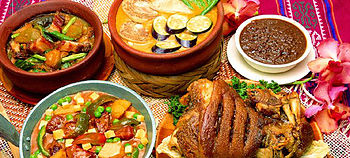
Filipino cuisine is composed of the cuisines of more than a hundred distinct ethnolinguistic groups found throughout the Philippine archipelago. A majority of mainstream Filipino dishes that comprise Filipino cuisine are from the food traditions of various ethnolinguistic groups and tribes of the archipelago, including the Ilocano, Pangasinan, Kapampangan, Tagalog, Bicolano, Visayan, Chavacano, and Maranao ethnolinguistic groups. The dishes associated with these groups evolved over the centuries from a largely indigenous (largely Austronesian) base shared with maritime Southeast Asia with varied influences from Chinese, Spanish, and American cuisines, in line with the major waves of influence that had enriched the cultures of the archipelago, and adapted using indigenous ingredients to meet local preferences.
Dishes range from the very simple meal of fried salted fish and rice to curries, paellas, and cozidos of |Iberian origin made for fiestas. Popular dishes include lechón (whole roasted pig), longganisa (Philippine sausage), tapa (cured beef), torta (omelette), adobo (vinegar and soy sauce-based stew), kaldereta (meat stewed in tomato sauce and liver paste), mechado (larded beef in soy and tomato sauce), pochero (beef and bananas in tomato sauce), afritada (chicken or beef and vegetables simmered in tomato sauce), kare-kare (oxtail and vegetables cooked in peanut sauce), pinakbet (kabocha squash, eggplant, beans, okra, bitter melon, and tomato stew flavored with shrimp paste), sinigang (meat or seafood with vegetables in sour broth), pancit (noodles), and lumpia (fresh or fried spring rolls). (Full article...)
Selected ingredient –

Sun-dried tomatoes are ripe tomatoes that lose most of their water content after spending a majority of their drying time in the sun. These tomatoes are usually pre-treated with sulfur dioxide or salt before being placed in the sun in order to improve color and appearance. Typically, tomatoes spend 4–10 days in the sun in order for the sun-drying process to be complete. Cherry tomatoes will lose 88% of their initial (fresh) weight, while larger tomatoes can lose up to 93% during the process. As a result, it takes anywhere from 8 to 14 kilograms of fresh tomatoes to make a single kilogram of sun-dried tomatoes.
After the procedure, the tomato fruits will keep their nutritional value. The tomatoes are high in lycopene, antioxidants, and vitamin C. The final products may contain up to 2–6% of salt and could provide a significant contribution to the day's intake. Sun-dried tomatoes can be used in a wide variety of recipes and come in a variety of shapes, colors, and types of tomato. Traditionally, they were made from dried red plum tomatoes, but they can be purchased in yellow varieties. Sun-dried tomatoes are also available in the form of pastes or purées. (Full article...)
Selected recipe –
Kimchi (/ˈkɪmtʃiː/; Korean: 김치; RR: gimchi, IPA: [kim.tɕʰi]) is a traditional Korean side dish (banchan) consisting of salted and fermented vegetables, most often napa cabbage or Korean radish. A wide selection of seasonings is used, including gochugaru (Korean chili powder), spring onions, garlic, ginger, and jeotgal (a salted seafood). Kimchi is also used in a variety of soups and stews. Kimchi is a staple food in Korean cuisine and is eaten as a side dish with almost every Korean meal.
There are hundreds of different types of kimchi made with different vegetables as the main ingredients. Traditionally, winter kimchi, called gimjang, was stored in large earthenware fermentation vessels, called onggi, in the ground to prevent freezing during the winter months and to keep it cool enough to slow down the fermentation process during summer months. The process of making kimchi was called kimjang and was a way for the whole village to participate. The vessels are also kept outdoors in special terraces called jangdokdae. In contemporary times, household kimchi refrigerators are more commonly used. (Full article...)
New Paltz station is a former train station in the village of New Paltz in Ulster County, New York. The building was the first of two railroad stations constructed in the town of New Paltz, and it is the only former Wallkill Valley Railroad station standing at its original location.
After a lengthy public debate over whether to place the station to the east or west of the Wallkill River, it was built in 1870 on the east bank, within the village of New Paltz. The rail line was formally opened during a large ceremony on December 20, 1870. A decade later the station had become a popular departure point for the Mohonk Mountain House by many vacationers, including two U.S. presidents. In the late 19th century, over a dozen stagecoaches ran between the station and Mohonk daily. (Full article...)
Selected image –
Selected biography –
B. January 22, 1939 – d. July 7, 2004
Jeffrey L. Smith (January 22, 1939 – July 7, 2004) was the author of several cookbooks and the host of The Frugal Gourmet, a popular American cooking show. The show began in Tacoma, Washington, as Cooking Fish Creatively on local PBS station KTPS (now KBTC), where it aired from 1973 to 1977. It then moved to WTTW in Chicago, and finally to KQED in San Francisco where it aired from 1984 to 1997. From 1972 to 1983, Smith was the owner and operator of the Chaplain's Pantry Restaurant and Gourmet Shop. (Full article...)
Did you know (auto-generated) –

- ... that food stylist Susan Spungen estimated that she baked hundreds of pies with Josh Brolin and film staff while practicing for a scene in Labor Day?
- ... that Turkish migrant workers living in a residential complex in Amsterdam refused to eat the Dutch food for two weeks after the kitchen's only Turkish chef was fired?
- ... that food YouTuber Mike Chen also runs a channel documenting strange phenomena?
- ... that food was left to rot outside after the supermarket Supie went out of business?
- ... that environmental activist Nigel Savage created Hazon after googling "Jewish food movement" and receiving zero search results?
- ... that strawberry pie is one of the "red foods" traditionally served at Juneteenth celebrations?
More did you know –
Related portals
Food topics
The following are topics relating to food
Categories
Food list articles
- See also: Lists of foods and Category:Lists of drinks
The following are some Food list articles on Wikipedia:

- American cheeses
- Appellation d'Origine Contrôlée cheeses
- Apple cultivars
- Bacon dishes
- Bacon substitutes
- Basil cultivars
- Breads
- Breakfast beverages
- Breakfast cereals
- Breakfast foods
- British cheeses
- Cakes
- Candies
- Cheeses
- Cheese soups
- Christmas dishes (list)
- Cocktails
- Cookies
- Dishes using coconut milk
- Diets
- Doughnut varieties
- Egg dishes
- Fermented soy products
- Food additives
- Food additives (Codex Alimentarius)
- Foods named after people
- French cheeses
- French dishes
- Fried dough foods
- Fruits
- List of hamburgers
- Herbs and spices
- Hors d'oeuvre
- Indian dishes
- Indian snack foods
- Indonesian dishes
- Italian dishes
- Japanese snacks
- Japanese dishes
- Jewish dishes
- Kebabs
- Korean beverages
- Mango cultivars
- Moroccan dishes
- Pasta
- Pastries
- Philippine snack food
- Pies, tarts and flans
- Poppy seed pastries and dishes
- Potato dishes
- Puddings
- Raw fish dishes
- Rice dishes
- Rolled foods
- Sauces
- Seafood
- Seeds
- Sandwiches
- Snack foods
- Soft drinks by country
- Soul foods and dishes
- Soups
- Stews
- Street foods
- Tapas
- Turkish dishes
- Twice-baked foods
- Vegetable oils
- Vegetables
- Vodkas
Things you can do
Related WikiProjects
| Parent project: WikiProject Food and Drink | |
| Child projects: | Task forces: (All inactive) |
|
|
| Related projects: | |
New articles
Rules | Match log | Results page (for watching) | Last updated: 2024-11-05 19:17 (UTC)
Note: The list display can now be customized by each user. See List display personalization for details.
- Is a hot dog a sandwich? (edit | talk | history | links | watch | logs | tools) by MontanaMako (talk · contribs · new pages (27)) started on 2024-11-05, score: 20
- 5-Methylfurfuryl alcohol (edit | talk | history | links | watch | logs | tools) by Reconrabbit (talk · contribs · new pages (14)) started on 2024-11-05, score: 10
- Tree Pull Scheme (edit | talk | history | links | watch | logs | tools) by CineBrick315 (talk · contribs · new pages (5)) started on 2024-11-05, score: 10
- Hiroshi Shintani (edit | talk | history | links | watch | logs | tools) by TSUBAME98 (talk · contribs · new pages (21)) started on 2024-11-05, score: 10
- Yoon Do-young (edit | talk | history | links | watch | logs | tools) by Explicit (talk · contribs · new pages (25)) started on 2024-11-04, score: 10
- J.C. Escarra (edit | talk | history | links | watch | logs | tools) by Muboshgu (talk · contribs · new pages (8)) started on 2024-11-04, score: 10
- My Cola Beverages (edit | talk | history | links | watch | logs | tools) by Abishe (talk · contribs · new pages (47)) started on 2024-11-03, score: 20
- Tongmo (edit | talk | history | links | watch | logs | tools) by The Bangsawan (talk · contribs · new pages (7)) started on 2024-11-03, score: 10
- List of cafés in Brussels (edit | talk | history | links | watch | logs | tools) by JhowieNitnek (talk · contribs · new pages (6)) started on 2024-11-01, score: 20
- Southport Raw Bar (edit | talk | history | links | watch | logs | tools) by ThadeusOfNazereth (talk · contribs · new pages (2)) started on 2024-11-02, score: 10
- Stone Castle (Kosovar winery) (edit | talk | history | links | watch | logs | tools) by Leutrim.P (talk · contribs · new pages (38)) started on 2024-11-02, score: 10
- Nasischijf (edit | talk | history | links | watch | logs | tools) by The Bangsawan (talk · contribs · new pages (7)) started on 2024-11-02, score: 10
- Kim In-hyeok (edit | talk | history | links | watch | logs | tools) by Explicit (talk · contribs · new pages (25)) started on 2024-11-01, score: 10
- Country Life Vlog (edit | talk | history | links | watch | logs | tools) by Scherbatsky12 (talk · contribs · new pages (1)) started on 2024-11-01, score: 10
- Ichijū-sansai (edit | talk | history | links | watch | logs | tools) by The Bangsawan (talk · contribs · new pages (7)) started on 2024-10-29, score: 10
- Red Ant Chutney (edit | talk | history | links | watch | logs | tools) by Elton-Rodrigues (talk · contribs · new pages (3)) started on 2024-10-31, score: 20
- Cockerel as food (edit | talk | history | links | watch | logs | tools) by By caner28 (talk · contribs · new pages (2)) started on 2024-10-30, score: 10
- Korv Stroganoff (edit | talk | history | links | watch | logs | tools) by Blockhaj (talk · contribs · new pages (26)) started on 2024-10-30, score: 20
- Tunisian Beverage Manufacturing Company (edit | talk | history | links | watch | logs | tools) by محمد أمين الطرابلسي (talk · contribs · new pages (9)) started on 2024-10-28, score: 10
- Sheetz–Wawa rivalry (edit | talk | history | links | watch | logs | tools) by Dan Leonard (talk · contribs · new pages (5)) started on 2024-10-28, score: 10
- Tight Tacos (edit | talk | history | links | watch | logs | tools) by Another Believer (talk · contribs · new pages (70)) started on 2024-10-27, score: 10
- Press (restaurant) (edit | talk | history | links | watch | logs | tools) by Another Believer (talk · contribs · new pages (70)) started on 2024-10-27, score: 10
- Edmonds (brand) (edit | talk | history | links | watch | logs | tools) by Panamitsu (talk · contribs · new pages (11)) started on 2024-10-27, score: 10
- Sushi Ichimura (edit | talk | history | links | watch | logs | tools) by Another Believer (talk · contribs · new pages (70)) started on 2024-10-27, score: 10
- Tenant for Death (edit | talk | history | links | watch | logs | tools) by Lord Cornwallis (talk · contribs · new pages (232)) started on 2024-10-27, score: 10
- McKroket (edit | talk | history | links | watch | logs | tools) by PhotographyEdits (talk · contribs · new pages (11)) started on 2024-10-26, score: 10
- Ttongsul (edit | talk | history | links | watch | logs | tools) by GucciNuzayer (talk · contribs · new pages (1)) started on 2024-10-27, score: 10
- World Egg Day (edit | talk | history | links | watch | logs | tools) by UzbukUdash (talk · contribs · new pages (26)) started on 2024-10-27, score: 20
- Kate's Ice Cream (edit | talk | history | links | watch | logs | tools) by Another Believer (talk · contribs · new pages (70)) started on 2024-10-27, score: 10
- Morino physic garden (edit | talk | history | links | watch | logs | tools) by MChew (talk · contribs · new pages (10)) started on 2024-10-27, score: 10
- Shmoné (edit | talk | history | links | watch | logs | tools) by Another Believer (talk · contribs · new pages (70)) started on 2024-10-26, score: 10
- Bob Goss (Texas Ranger) (edit | talk | history | links | watch | logs | tools) by No No No No Name fu (talk · contribs · new pages (12)) started on 2024-10-26, score: 10
- Dreaming of a Vetter World (edit | talk | history | links | watch | logs | tools) by Thriley (talk · contribs · new pages (109)) started on 2024-10-26, score: 10
- Kid Curtis (edit | talk | history | links | watch | logs | tools) by MaugerFundin (talk · contribs · new pages (11)) started on 2024-10-26, score: 10
- Bonet (dessert) (edit | talk | history | links | watch | logs | tools) by JacktheBrown (talk · contribs · new pages (2)) started on 2024-10-26, score: 20
- Barker's of Geraldine (edit | talk | history | links | watch | logs | tools) by Cloventt (talk · contribs · new pages (2)) started on 2024-10-25, score: 20
- Dinner with Drac (edit | talk | history | links | watch | logs | tools) by Kjell Knudde (talk · contribs · new pages (465)) started on 2024-10-25, score: 20
- Belgian Beer Pong Championship (edit | talk | history | links | watch | logs | tools) by Wouterpeeters81 (talk · contribs · new pages (1)) started on 2024-10-24, score: 20
- Spiral (Brooke Candy album) (edit | talk | history | links | watch | logs | tools) by BiggestBidder (talk · contribs · new pages (1)) started on 2024-10-25, score: 10
- List of gin distilleries in England (edit | talk | history | links | watch | logs | tools) by ChefBear01 (talk · contribs · new pages (1)) started on 2024-10-24, score: 20
- Austin Bush (edit | talk | history | links | watch | logs | tools) by Paul 012 (talk · contribs · new pages (57)) started on 2024-10-24, score: 10
- Pié d'Angloys (edit | talk | history | links | watch | logs | tools) by Lemjas (talk · contribs · new pages (1)) started on 2024-10-23, score: 20
- 2024 McDonald's E. coli outbreak (edit | talk | history | links | watch | logs | tools) by ElijahPepe (talk · contribs · new pages (14)) started on 2024-10-22, score: 10
- Smaaken Waffle Sandwiches (edit | talk | history | links | watch | logs | tools) by Another Believer (talk · contribs · new pages (70)) started on 2024-10-22, score: 10
- ZIWI (edit | talk | history | links | watch | logs | tools) by Possummayhem (talk · contribs · new pages (1)) started on 2024-10-16, score: 10
- Chicken breast steak with peach (edit | talk | history | links | watch | logs | tools) by Aaa000000 (talk · contribs · new pages (1)) started on 2024-10-23, score: 10
- Guapple pie (edit | talk | history | links | watch | logs | tools) by FromFrank (talk · contribs · new pages (2)) started on 2024-10-23, score: 20
- Reverend's BBQ (edit | talk | history | links | watch | logs | tools) by Another Believer (talk · contribs · new pages (70)) started on 2024-10-23, score: 10
- Roberto Gómez (baseball) (edit | talk | history | links | watch | logs | tools) by Ce Ele 415 (talk · contribs · new pages (2)) started on 2024-10-22, score: 10
Associated Wikimedia
The following Wikimedia Foundation sister projects provide more on this subject:
-
Commons
Free media repository -
Wikibooks
Free textbooks and manuals -
Wikidata
Free knowledge base -
Wikinews
Free-content news -
Wikiquote
Collection of quotations -
Wikisource
Free-content library -
Wikiversity
Free learning tools -
Wiktionary
Dictionary and thesaurus






